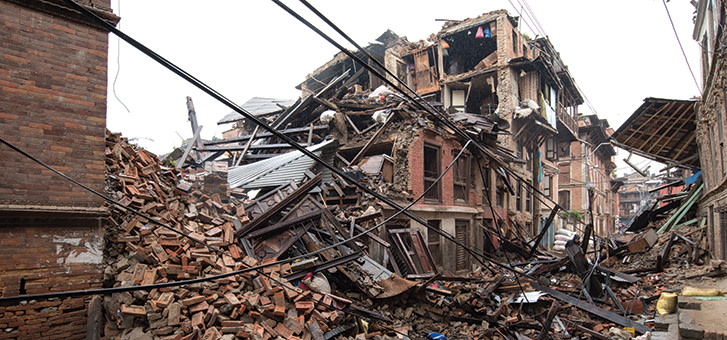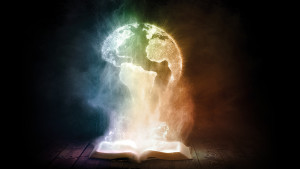Sita remembers that April day when she was out watching the family’s cattle as they grazed. The seven-year-old was lying on the grass on a Nepalese hillside, watching the clouds float overhead. Suddenly, she knew something was terribly wrong. The ground was heaving up and down, and she could see dust rising like a fog on the surrounding hills. Later, she told aid workers that she curled up on the grass and cried.
Five months later, Manuel Moya and his wife were in bed watching television when an earthquake hit his town of Illapel in Chile. The violence of the shaking caused Moya and his wife to dash out to the street in their underwear. They may have lacked a degree of modesty, but they saved their lives—three minutes later, their building was reduced to rubble.
“I thought it was the end of the world,” Moya told the National Post.
Some people think Moya might have been exactly right. They see the event in Chile last year as another in a series of earthquakes that are building in strength and frequency to an end-time crescendo.
Hal Lindsey, the world’s best-known expounder of Bible prophecy, wrote in his 1997 book Apocalypse Code, “Earthquakes continue to increase in frequency and intensity, just as the Bible predicted for the last days before the return of Christ. History shows that the number of killer quakes remained fairly constant until the 1950s—averaging between two to four per decade. In the 1950s, there were nine. In the 1960s, there were 13. In the 1970s there were 51. In the 1980s there were 86. From 1990 through 1996, there have been more than 150.”
He’s right when he says that Jesus specifically pointed to earthquakes as a sign of the end: “There will be famines and earthquakes in various places. All these are the beginning of birth pains” (Matthew 24:7, 8).
In other words, when you see earthquakes, something big is going down. And, right now, the world is shaking like a maraca at a salsa festival. It’s not just shaking, it’s shaking hard. Of the five most violent earthquakes on record, all have happened since World War II. One of the worst happened only five years ago. You no doubt remember watching on TV as the tsunami rolled across the Japanese coast after a quake rang the Richter bell at a magnitude of 9.0. I recall a video from that event showing a hanging chandelier swinging so wildly that its sides hit the ceiling.
The tragedy was a rude surprise to seismologists who had felt confident the Japan Trench would never generate an earthquake larger than 8.0 on the Richter scale—maybe 8.4 at the most.
In 2004, the Indian Ocean earthquake went even further up the Richter scale to 9.1–9.3, making it one of the most deadly natural disasters of all time. It really does seem like “the whole creation has been groaning as in the pains of childbirth” (Romans 8:22).
So is it time to get under your desk with some bottled water and wait for the apocalypse? Maybe, but before you cancel all your appointments in this world in preparation for the next, take a moment to check the facts.
First of all, are Lindsey and the other preachers on prophecy correct when they say earthquakes are happening more and more frequently? This is easy to check, because excellent records on earthquakes have been kept for more than a century.
Start by plotting on a graph the number of earthquakes of a magnitude of 6.5 or more that have taken place each year since 1900. You’ll end up with a bunch of dots that fall all over the place. It’s confusing. But if you call that cousin who was pretty good at maths to crunch the numbers, you’ll see a trend showing that significant earthquakes are actually less frequent than they were in the mid-1900s. This certainly doesn’t fit with statements about earthquake frequency from Lindsey and other preachers of prophecy. Since Lindsey didn’t give the source for his information, his arguments collapse like an apartment building in the 1976 Tangshan earthquake.
What about the size of the temblors? Is God putting more shake into today’s quakes? Among the 10 events of the greatest magnitude that are on record, two are indeed in our century. On the other hand, the two worst earthquakes go back half a century, including the 1964 Alaska earthquake that smashed Anchorage like cheap crockery and churned up tsunamis that affected 20 countries. The other big quakes are randomly sprinkled over history back to the Middle Ages.
When the dust clears, we don’t seem to be in an earthquake Armageddon. Based on current trends, there’s no need for you to pack your favourite teacups in bubble wrap. But even if the quakes we see on the news are not an opening act for the final apocalypse, many of these disasters do bring about the end of the world in a different sense.
It was the day after Christmas in 2004 when the Indian Ocean earthquake and tsunami took the lives of a staggering 230,000 people. For them, it was the end of the world. It reminds us that the end of time can come as an individual event as well as a prophetic one. It can come to us personally long before there is a worldwide apocalypse.
I don’t know who can really feel ready for such a judgement day, whether it comes from a tsunami or something more mundane, such as slipping in the bathroom. It makes me think of a friend of mine who was a pillar in the community. He was an all-round nice guy—always quick to lend a hand to friends and strangers alike. The members of his church depended on his generous help for everything from fundraising to fixing the plumbing.
Then he suffered a heart attack. As he made the long trip to the hospital in the back of an ambulance, he felt unprepared for his personal judgement day. “I knew I wasn’t ready,” he said.
The experience transformed his faith. Now he trusts in Jesus to save him and not in his good deeds. And now he’s different in a way that’s too sublime to describe. I would dare to say that he’s ready for the end of the world, whether it happens for all of God’s creation or just for him. My friend inspires me to live with an eye to that future life in what the apostle Paul calls “a kingdom that cannot be shaken” (Hebrews 12:28).






